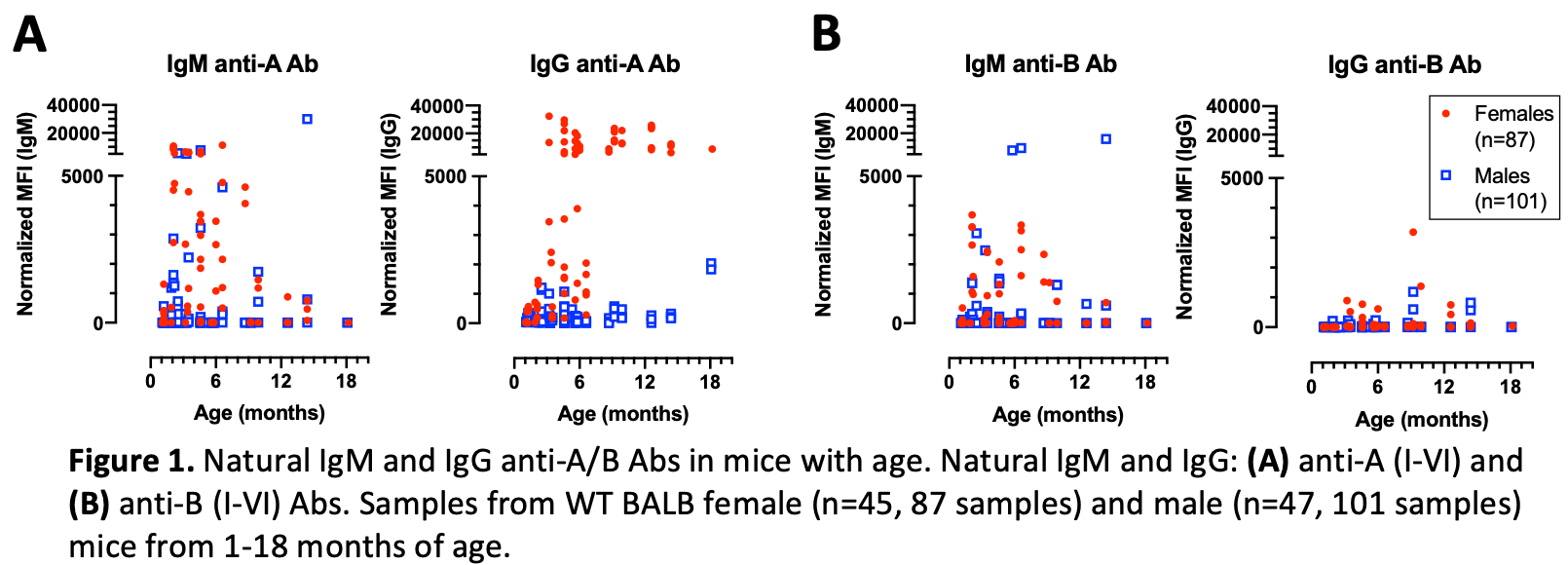Female complexity: High ‘natural’ ABO anti-A antibodies and IgG class switch in female vs male mice
Bushra Anjum1, Ibrahim Adam1,2,3, Jordana Fersovich1, Maurits Sulzer1, Jean Pearcey1,2, Kesheng Tao1,2, Bruce Motyka1,2, Lori J. West1,2,3,4.
1Department of Pediatrics, Alberta Transplant Institute, University of Alberta, Edmonton, AB, Canada; 2Canadian Donation and Transplantation Research Program, University of Alberta, Edmonton, AB, Canada; 3Department of Medical Microbiology & Immunology, University of Alberta, Edmonton, AB, Canada; 4Departments of Surgery and Laboratory Medicine & Pathology, University of Alberta, Edmonton, AB, Canada
Introduction: ABO histo-blood group incompatibility is a barrier in solid organ transplant due to the presence of ‘natural’ preformed ABO antibodies (Abs). However, ABO-incompatible (ABOi) heart transplantation is successful in infants as ABO Abs are low/absent. A better understanding of the specificity and the production of ABO Abs may allow for successful ABOi transplantation at older ages. Here, we sought to determine the isotype (IgM/IgG) and subtype (I-VI) specificity of ABO Abs produced naturally or induced by sensitization in mice as a function of age and sex.
Methods: BALB/c mice were assessed for natural anti-A and anti-B Ab production over time (n=45/47, female/male; age 1-18 months), or challenged with human A erythrocytes (5 weekly ip injection) beginning at age 5 weeks to measure induced anti-A Abs (n=13/8, female/male; age 1-3 months). Plasma A/B Ab titre was determined by hemagglutination assay using human reagent erythrocytes; ABO Ab isotype and subtype-specificity were assessed by a novel ABH glycan microarray created in our lab.
Results: Female mice produced markedly higher natural anti-A Abs compared to male mice. With age, natural anti-A shifted from IgM to IgG isotype in females but remained predominantly IgM in males (Fig. 1A). In contrast to anti-A, anti-B Ab levels were much lower and remained mostly IgM in both sexes (Fig. 1B). Most natural anti-A Abs were specific to antigen subtypes III/IV; specificity to subtypes I and II was absent or very low. In contrast, following A-antigen sensitization, female and male mice produced comparable quantities of IgM and IgG anti-A Abs (data not shown), with specificities for all subtypes (I-VI).

Conclusions: We found a dramatic and previously undescribed sex difference in natural ABO anti-A Ab production in mice. Markedly higher anti-A Ab production together with a distinct propensity for class switching suggest a more complex immune pathway in females than traditionally described for natural Abs to ‘T-independent’ carbohydrate antigens. Future studies will explore mechanisms for these sex differences and relevance to humans.
Supported by the Heart and Stroke Foundation of Canada and the Women and Children’s Health Research Institute, University of Alberta.
There are no comments yet...